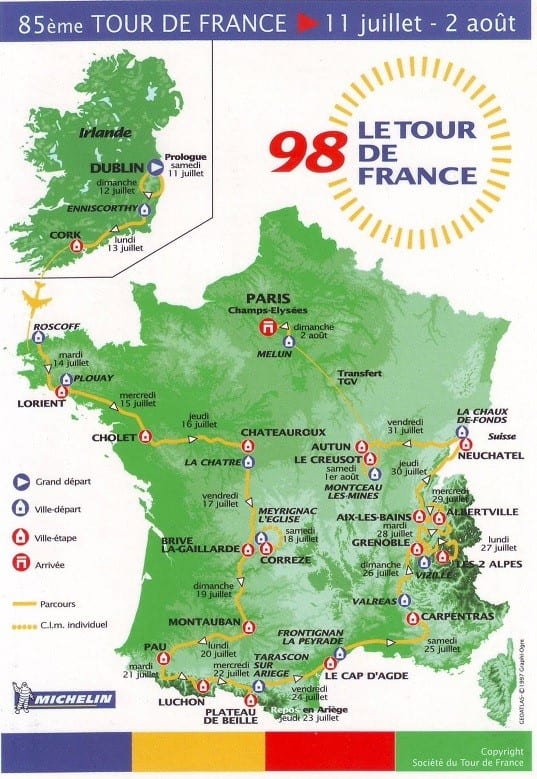For most, the 1998 Tour de France is (infamously) remembered for the Festina affair, which saw the expulsion of the team from the race after team soigneur, Willy Voet, was intercepted at the Belgian-French border with huge amounts of EPO, growth hormone, testosterone and amphetamines. TVM were also ejected and in hindsight, we know that almost the whole peloton was doped.

I remember it very differently. I was an exchange student in France at the time and a family friend from Pau invited me to stay and see a Pyrenéen stage. I was aware of the polemics surrounding the race but these thoughts were more or less erased by the thought of seeing my heros tackle some of the Tour’s most famed climbs.
Besides the cycling, a great thing about visiting the Tour is seeing parts of France you otherwise may not. While Paris is a beautiful city, it could be argued that the true beauty of the country is to be found out of the capital where things move a bit slower and traditional ways of life persist. This is definitely true of Pau. The locals speak differently - with l’accent du sud as the Parisians say - it’s softer, friendlier even. The food is rich, the countryside lush and green and the mountains tall and steep.
On the morning of Tuesday July 21, my friend, Mireille, and I packed some baguettes and set off for the Col d’Aubisque. It was the first climb of a big day that also included the Col de Tourmalet, Col d’Aspin and Col de Peyresourde.

The atmosphere on a Tour de France mountain pass is hard to describe - there’s a frisson, as the French would say. The excitement builds throughout the day. Camper vans line the road parked at unlikely angles. Families sit around makeshift campsites, chairs and tables tilted, listening to their radios and relaxing.
We climbed until we found a good vantage point and then settled in for the day. I familiarised myself with the surroundings - making sure to locate the perfect spot to take photos. Then I took out my chalk and wrote ‘O’Grady’ in giant letters on the coarse Pyrenéen asphalt. Every now and then, an amateur cyclist lumbered past, grinding his way up the slope. Everyone would cheer, as if rehearsing for what was to come.
The tension continues to build. About two hours before the first riders come through, the advertising caravan - a long, heaving behemoth of cars festooned with decorations and slogans - lumbers past. It consists of about 250 vehicles, each playing music and ejecting hats, bottles, bags and other merchandise. In any other context it would be a bit obscene, but it’s an integral part of the Tour and is yet another element that shapes the day into something special and spectacular.
Eventual winner, Pantani, and defending champion, Ullrich, during the 1998 Tour. Photo: www.spiegel.de
Once the caravan passes, a period of silence ensues - everyone prepares themselves for the main event. And then we wait one more time. The fog on the day added to the suspense as it was only possible to see about 100 metres down the road. The first sign of the approaching cyclists is the distant rumble of the race helicopters. People rise from their chairs and emerge from their caravans. Then the lights of the first vehicles appear - one motorbike passes, then another and a car.
Finally, the strung-out peloton materialises. As this was the first climb of a long day, the riders were more or less together. Nonetheless, there’s a lot to see on the side of a steep hill as the action is slowed down. You can notice little details - Ullrich climbing in the big ring, Pantani out of the saddle in the drops, Robin’s jersey unzipped and flapping despite the cold. I cheer for my heroes - O’Grady, McEwan, Stephens (all my heroes were Australian at that stage!).
And then, as quickly as they emerge, they are gone. The voiture balai (broom wagon) marks a full stop on the action. I was exhilarated for days afterwards. I picked up three bidons and a Lotto-Mobistar cap, stained with sweat, that had been discarded by passing cyclists. These are better than any souvenir you can buy and, along with my memories, I treasure them to this day.
